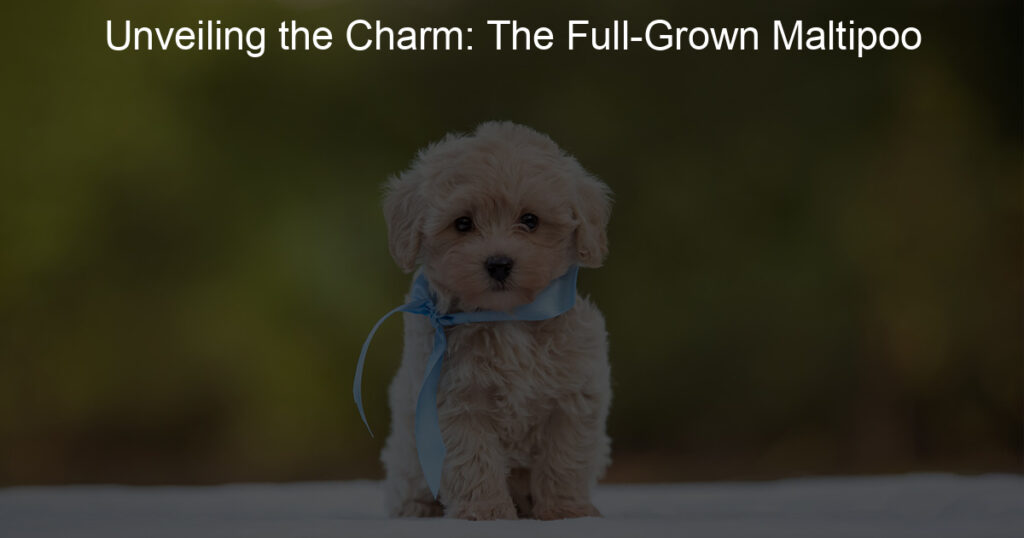
Introduction to Maltipoo Gender Differences
Welcome to our comprehensive guide on Maltipoo gender differences. This guide is designed to provide you with all the information you need to understand the unique characteristics of both male and female Maltipoos. Whether you’re considering adopting a Maltipoo or you’re a proud Maltipoo owner looking to learn more, this guide is for you.
- Overview of Maltipoo breed
- Importance of understanding gender differences
The Maltipoo is a popular breed known for its friendly nature and adorable appearance. This breed is a cross between a Maltese and a Poodle, combining the best traits of both breeds. Maltipoos are usually small in size, with a weight range of 5 to 20 pounds. They have a fluffy coat that comes in a variety of colors, including white, black, and brown. Maltipoos are known for their intelligence, making them easy to train. They are also known for their playful and affectionate nature, making them great companions.
Understanding the gender differences in Maltipoos can help you make an informed decision when choosing a pet. It can also help you better understand your pet’s behavior and needs. While both male and female Maltipoos make excellent pets, they can have different characteristics and behaviors. For example, male Maltipoos may be more playful and outgoing, while female Maltipoos may be more reserved and independent. By understanding these differences, you can choose a pet that best fits your lifestyle and preferences.
In the following sections, we will delve deeper into the specific characteristics of male and female Maltipoos, and compare their behaviors. We will also provide tips on choosing a Maltipoo that suits your lifestyle. So, let’s dive in and explore the wonderful world of Maltipoos!
Choosing a Maltipoo: Factors to Consider
When deciding to bring a Maltipoo into your home, there are several factors to consider. These include your living conditions, family dynamics, and the presence of other pets in your household. Let’s delve into these factors to help you make an informed decision.
- Living Conditions
- Family Dynamics
- Other Pets in the Household
Maltipoos are adaptable and can thrive in various living conditions, from apartments to large homes with yards. However, they are active dogs that require daily exercise. Therefore, you need to ensure that you have enough space for them to move around. If you live in an apartment, consider the availability of a nearby park or a safe walking path for your Maltipoo’s daily walks.
Maltipoos are sociable and love being part of a family. They get along well with children and adults alike. However, they require attention and care. If your family is often away from home or too busy to engage with a pet, a Maltipoo may not be the best choice. On the other hand, if your family enjoys activities that a Maltipoo can participate in, this breed could be a perfect fit.
Generally, Maltipoos get along well with other pets. They are friendly and can coexist peacefully with other dogs and even cats. However, it’s essential to consider the temperament of your existing pets. If they are territorial or not used to sharing their space, they might not welcome a new pet. It’s recommended to introduce the Maltipoo to your other pets gradually and under supervision to ensure a smooth transition.
In conclusion, choosing a Maltipoo requires careful consideration of your living conditions, family dynamics, and the presence of other pets in your household. By taking these factors into account, you can ensure a happy and harmonious relationship with your new furry friend.
Male Maltipoo Characteristics
When considering a Maltipoo as a pet, it’s important to understand their characteristics. Male Maltipoos, in particular, have unique physical and behavioral traits that set them apart. Let’s delve into the physical aspects of a male Maltipoo.
Physical Traits of a Male Maltipoo
Male Maltipoos have distinct physical features that make them stand out. Here are some of the key characteristics to note:
- Size and Weight
- Coat Color and Texture
Male Maltipoos typically stand between 8 to 14 inches tall at the shoulder and weigh between 5 to 20 pounds. Their size can vary depending on the size of their Poodle parent, but they are generally small dogs with a sturdy build.
The coat of a male Maltipoo can come in a variety of colors including white, black, brown, cream, and grey. They often have a wavy or curly coat that is soft to the touch. This is a result of their Maltese and Poodle heritage. Their coat is also hypoallergenic, making them a good choice for individuals with allergies.
Understanding these physical traits can help you better care for your male Maltipoo. From knowing the right amount of food to feed them based on their size, to grooming their unique coat, these traits are essential to know for any potential Maltipoo owner.
Behavioral Traits of a Male Maltipoo
When it comes to understanding the behavior of a male Maltipoo, there are two key areas to focus on: aggression levels and social behavior. Let’s delve into these aspects to get a clearer picture.
- Aggression Levels
- Social Behavior
Male Maltipoos are generally known for their friendly and affectionate nature. However, like any other breed, they can exhibit signs of aggression if not properly trained or socialized. It’s important to note that aggression in dogs is often a response to fear or a perceived threat. Therefore, it’s crucial to provide a safe and nurturing environment for your Maltipoo.
Early socialization and obedience training can help mitigate any potential aggression. Remember, a well-behaved Maltipoo is a result of patient, consistent, and positive reinforcement training methods.
Male Maltipoos are known for their sociable and outgoing nature. They love being the center of attention and enjoy the company of their human family members. They are also generally good with other dogs and pets, making them a great choice for multi-pet households.
However, it’s important to remember that each Maltipoo is an individual and their social behavior can be influenced by factors such as their upbringing, training, and overall health. Therefore, it’s always recommended to spend quality time with your Maltipoo, engaging them in interactive games and activities to foster their social skills.
In conclusion, understanding the behavioral traits of a male Maltipoo can help you provide the right environment and care for your furry friend. Remember, a happy and well-adjusted Maltipoo is a result of a loving and understanding home.
Selecting a Male Maltipoo: Case Studies
Let’s take a closer look at two real-life examples of families who chose a male Maltipoo as their pet. These case studies will provide practical insights into the process of selection and the experiences that followed.
- Case Study 1: The Johnson Family
- Case Study 2: Mrs. Smith
The Johnsons were a family of four, with two young children. They were looking for a small, friendly dog that could adapt to apartment living. After researching various breeds, they decided on a male Maltipoo due to his compact size and sociable nature.
They named him Max. Max quickly became a beloved member of the family. His playful and affectionate behavior was a hit with the kids. Max’s coat required regular grooming, but the family found this to be a bonding activity rather than a chore. The Johnsons reported that Max was easy to train and had a low level of aggression, making him an ideal pet for their young family.
Mrs. Smith, a retired teacher, was seeking a companion in her golden years. She chose a male Maltipoo named Charlie for his hypoallergenic coat and his reputation as a good companion dog.
Charlie proved to be a great fit for Mrs. Smith. He was calm, affectionate, and enjoyed their daily walks. Mrs. Smith found Charlie’s social behavior to be a plus, as he was always friendly with visitors and other dogs in the park. She also appreciated that Charlie’s size made him easy to manage, especially as she had some mobility issues.
As these case studies show, male Maltipoos can make excellent pets for a variety of households. Their friendly nature, manageable size, and adaptable behavior make them a popular choice for families and individuals alike.
Female Maltipoo Traits
If you’re considering adopting a Maltipoo, understanding the traits of a female Maltipoo can help you make an informed decision. Let’s explore the physical characteristics of a female Maltipoo.
Physical Characteristics of a Female Maltipoo
Female Maltipoos are unique in their own ways. They have distinctive physical features that set them apart. Here are some of the key physical traits of a female Maltipoo:
- Size and weight: Female Maltipoos are typically smaller than their male counterparts. They usually weigh between 5 to 15 pounds and stand about 8 to 12 inches tall at the shoulder. Remember, the size can vary depending on the parents’ size.
- Coat color and texture: The coat of a female Maltipoo can come in a variety of colors, including white, black, brown, cream, and all shades in between. The texture of their coat is usually soft and curly, resembling a cotton ball. Regular grooming is required to keep their coat looking its best.
Understanding these physical traits will help you better prepare for your potential new family member. Remember, each Maltipoo is unique, and these traits can vary from dog to dog.
Behavioral Characteristics of a Female Maltipoo
Understanding the behavior of a female Maltipoo can help you build a better relationship with your pet. Let’s explore two key behavioral traits: aggression levels and social behavior.
- Aggression Levels
- Social Behavior
Female Maltipoos are generally known for their friendly and loving nature. They are not typically aggressive. However, like any breed, their behavior can be influenced by their environment and upbringing. It’s important to note that aggression is not a common trait in Maltipoos, and if it does occur, it may be a sign of fear or anxiety. Training and socialization from a young age can help manage and prevent aggressive behavior.
Female Maltipoos are social butterflies. They love being around people and are known for their affectionate and friendly demeanor. They enjoy playing and spending time with their human family members. They also get along well with other pets. However, they can sometimes be a bit shy around strangers, but with proper socialization, they can overcome this trait. Remember, a happy and well-socialized Maltipoo is a joy to have around.
In conclusion, female Maltipoos are generally friendly, loving, and social. They make great companions and family pets. However, like all dogs, they need proper training and socialization to ensure they grow up to be well-behaved and happy.
Selecting a Female Maltipoo: Case Studies
-
Case Study 1: Bella, the Friendly Maltipoo
Bella, a female Maltipoo, was chosen by the Johnson family. They were initially drawn to Bella due to her small size and fluffy white coat. However, they were also aware of the general behavioral traits of female Maltipoos, such as their lower aggression levels and sociable nature.
After bringing Bella home, the Johnsons found these traits to be true. Bella was friendly and got along well with the family’s two young children. She was also quick to make friends with the other dogs in the neighborhood. Bella’s size made her a perfect fit for the Johnson’s small apartment, and her coat was easy to maintain with regular grooming.
The Johnsons’ experience with Bella shows that understanding the traits of a female Maltipoo can help in making an informed decision when selecting a pet.
-
Case Study 2: Daisy, the Independent Maltipoo
Daisy, another female Maltipoo, was chosen by the Smith family. They were attracted to Daisy’s unique coat color and texture. They also appreciated the fact that female Maltipoos are known for their independence and lower aggression levels.
Once Daisy was brought home, the Smiths noticed that she was indeed independent and preferred to play on her own at times. However, she was never aggressive and was quite affectionate with the family members. Daisy’s coat required a bit more grooming than expected, but the Smiths found this to be a small trade-off for her lovely coat color and texture.
The Smiths’ experience with Daisy demonstrates that while female Maltipoos may have certain general traits, each dog’s personality and needs can vary. Therefore, it’s important to spend time with a Maltipoo before making a final decision.
Maltipoo Behavior Comparison: Male vs Female
When choosing a Maltipoo, it’s important to understand the behavioral differences between males and females. These differences can significantly impact your experience as a pet owner. Let’s delve into the comparison of aggression levels and social behavior between male and female Maltipoos.
- Comparison of aggression levels
Aggression in dogs can manifest in various ways, such as barking, growling, or biting. It’s essential to note that aggression is not gender-specific and can be influenced by various factors like training, socialization, and individual temperament.
Male Maltipoos, especially unneutered ones, can sometimes display more territorial aggression than their female counterparts. They may mark their territory more frequently and can be more protective of their space and their owners. However, with proper training and socialization from a young age, this behavior can be managed effectively.
On the other hand, female Maltipoos are generally less aggressive. They can be more independent and less likely to engage in territorial behaviors. However, they may display mood changes and become slightly more aggressive during their heat cycles, which occur twice a year.
- Comparison of social behavior
When it comes to social behavior, both male and female Maltipoos are known for their friendly and affectionate nature. They are great with kids and other pets, making them excellent family dogs.
Male Maltipoos are often more playful and outgoing. They tend to seek more attention and can be more affectionate towards their owners. They are also more likely to engage in playful behaviors with other dogs and people.
Female Maltipoos, while still friendly and sociable, can be a bit more reserved than males. They may take a bit more time to warm up to new people and situations. However, once they feel comfortable, they are just as loving and affectionate as their male counterparts.
In conclusion, both male and female Maltipoos have their unique behaviors. The choice between a male or female Maltipoo will depend on your personal preference and lifestyle. Remember, individual temperament and training play a significant role in shaping a dog’s behavior, regardless of their gender.
Maltipoo Pet Selection: Final Thoughts
As we wrap up our discussion on selecting a Maltipoo, it’s important to revisit some key points and takeaways. Remember, the decision to bring a pet into your home is a significant one, and understanding the differences between male and female Maltipoos can help ensure you make the best choice for your family.
- Revisiting the importance of understanding gender differences
Understanding the gender differences in Maltipoos is crucial in making an informed decision. Male Maltipoos, for instance, are generally more playful and energetic, while females tend to be more independent and reserved. These traits can significantly impact how well your new pet fits into your lifestyle and family dynamics.
For example, if you have young children, a male Maltipoo’s playful nature might be a better fit. On the other hand, if you’re looking for a more calm and independent pet, a female Maltipoo might be the right choice. Remember, these are general tendencies and individual dogs may vary.
- Key takeaways for choosing a Maltipoo
When choosing a Maltipoo, consider your lifestyle, the dog’s temperament, and your ability to meet their needs. Here are some key takeaways:
- Consider your lifestyle: Maltipoos are active and require regular exercise. Ensure you can provide this before bringing one into your home.
- Understand their temperament: Maltipoos are known for their friendly and affectionate nature. They thrive on companionship and do not do well when left alone for long periods.
- Meet their needs: Maltipoos require regular grooming due to their curly coats. They also need mental stimulation to keep them happy and healthy.
In conclusion, choosing a Maltipoo as a pet is a rewarding experience. They bring joy, companionship, and a whole lot of love. But remember, it’s a commitment that should not be taken lightly. Make sure you’re ready to provide a loving and caring home for your new furry friend.








